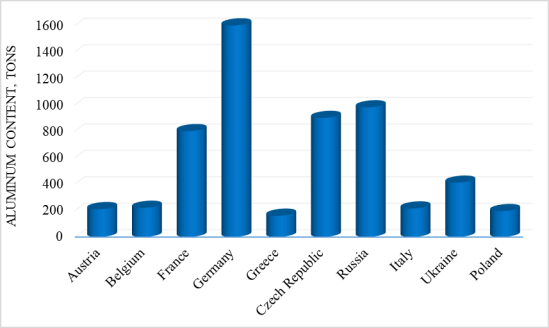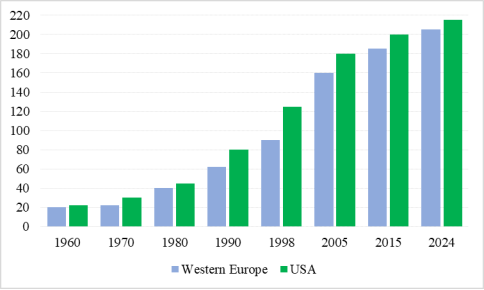This article presents information on global trends in aluminum production and application. Analysis of the use of light alloys based on aluminum in the transport sector has been conducted.
Keywords: Aluminum alloys, transport industry, lightweight materials, automotive applications, railway vehicles, aerospace structures, alloy production, mechanical properties, corrosion resistance, energy efficiency.
Although less than 200 years have passed since aluminum began to be developed on an industrial scale, it and its alloys have already firmly established themselves as the leading structural material after iron-based alloys. In the transport sector, the rates of production and development of steel and cast iron-based alloys are striking, while the use of aluminum alloys remains unsatisfactory: in 1857–0.007 tons; 18 tons in 1890; In 1913–8120 tons; In 1922–129,100 tons; in 1953–71,300 tons; 2004–31,100 million tons of primary aluminum; In 2016–43,200 million tons. The main method of aluminum production to date is the Bayer method.
The research results and their discussion show that the region with the largest aluminum production is North America, which accounts for 20 % of all aluminum produced in the world. In the following places: China — 19 %, Western Europe — 16 %; Asia, Oceania, and South America 8 % for each region; Africa — 5 %; Eastern Europe — 2 %; for all the rest — 14 %. The largest primary aluminum producers are: «Alcoa» with a share of 14 % of the total volume of production in the world; «Alkane» and «RusAl» with a 9 % share each; «Hydro» — 5 % and «Bilton» — 4 %. The most active consumers of aluminum in Europe are Germany, Russia, and France (Fig. 1).
Today, the amount of aluminum used in the industry of European countries averages 24.7 kilograms per person (Table 1).

Fig. 1. The largest aluminum consumers in Europe
The structure of the use of aluminum and its alloys in Europe is as follows: transport engineering — 26 %, construction industry — 20 %, packaging materials — 20 %, electrical engineering — 9 %, other industries — 25 %. These indicators are especially important in the production of passenger cars [1–2]. Therefore, the use of aluminum alloy products in passenger cars has a steady growth trend (Fig. 2).
Table 1
Average annual aluminum consumption per capita in Europe.
|
Country of Consumption |
Quantity, kg |
Country of Consumption |
Quantity, kg |
|
Netherlands |
40,1 |
France |
24,6 |
|
Italy |
32,3 |
Belgium |
24,2 |
|
Sweden |
31,6 |
Greece |
16,8 |
|
Norway |
29,3 |
United Kingdom |
17,2 |
|
Austria |
31,6 |
Spain |
13,9 |
|
Germany |
26,1 |
Portugal |
9,4 |
|
Switzerland |
26,4 |
Poland |
8,2 |
|
Denmark |
23,7 |
Ukraine |
8,4 |
In the modern automotive industry, the share of aluminum alloys is increasing. This process serves to reduce the total mass of vehicles, optimize fuel consumption, reduce the amount of harmful gases released into the atmosphere, and reduce the dynamic load on road surfaces (see Table 2).

Fig. 2. Trends in the use of aluminum alloys in passenger car manufacturing
In particular, the technology for producing structural elements based on foam materials based on aluminum is developing rapidly. At the same time, according to experts and industry experts, the maximum permissible norm for the use of aluminum alloys in passenger cars is limited to about 200 kg.
Table 2
Technical and economic indicators of using aluminum and its alloys in a European passenger car.
|
Year |
Average car weight, kg |
Average Aluminum and Alloy Usage per Vehicle, kg |
Fuel savings per 100 km of vehicle travel, in liters |
|
1995 |
1085 |
71 |
0,85 |
|
200 |
1026 |
100 |
1,20 |
|
2003 |
966 |
130 |
1,56 |
|
2005 |
926 |
150 |
1,80 |
|
2015 |
826 |
200 |
2,4 |
|
2024 |
800 |
220 |
2,8 |
According to leading heavy truck manufacturers Volvo, Scania, MAN, and Mercedes-Benz, the construction of modern trucks can use an average of up to 2380 kg of aluminum and its alloys. The high strength of the aluminum material, its relatively light weight, and corrosion resistance are the reasons for the widespread use of these metals in the automotive industry.
Thus, heavy trucks using aluminum and its alloys are a resource-saving, environmentally safe, and cost-effective solution. This approach will serve as an important factor for the sustainable development of industry and the practical implementation of the principles of a «green economy». In order to reduce the weight, increase energy efficiency, and ensure compliance with environmental requirements in the design and production of modern railway vehicles, the use of aluminum-based structural materials is expanding. Today, about 80 % of wagons operated in European countries have structures made of aluminum or its alloys. Such lightweight, corrosion-resistant, and mechanically durable materials reduce not only fuel consumption but also the degree of wear and tear by reducing load on the wagon.
The use of aluminum alloys in subway trains and trams allows for a twofold reduction in electricity consumption during acceleration and braking processes. This, in turn, contributes to the formation of an environmentally friendly transport system, along with reducing operating costs and increasing operational efficiency.
At the same time, the high processing and recyclability of materials based on aluminum makes them one of the most optimal solutions in accordance with the principles of sustainable development. These factors contribute to the widespread introduction of innovative technologies in the development of rolling stock.
Aluminum and its various alloys are especially widely used in the aviation and aerospace industries. In modern lightweight and medium-range aircraft, the share of aluminum alloys can account for up to 80 % of the total structural weight. This is due to aluminum's advantageous properties, such as high mechanical strength, low density, excellent machinability, and resistance to corrosion. In aerospace applications, even a minor reduction in weight can have a profound impact on fuel efficiency, range, and payload capacity, positioning aluminum alloys as strategically essential materials [2–4].
In recent years, continuous research efforts have been directed toward improving the quality of aluminum alloys used in aerospace and aviation technologies. These include molecular-level structural modifications, the development of next-generation microalloys, and the implementation of advanced quality control techniques such as ultrasonic and laser-based inspection methods. These innovative approaches aim to enhance the operational performance, reliability, and global competitiveness of aluminum-based materials, ensuring their compliance with the ever-increasing demands of the aerospace market.
These issues are of paramount importance due to the strategic role of aluminum in modern industries such as transportation, aerospace, construction, and electrical engineering. Addressing them requires a multidisciplinary approach involving materials science, process engineering, environmental sustainability, and industrial innovation.
Conclusions
The comprehensive set of measures aimed at improving the quality of secondary alloys includes the following key components:
– Rigorous sorting and classification of metal scrap and industrial waste, followed by the preparation of a high-quality charge mixture. This process ensures the production of alloys with precisely controlled chemical composition and a minimal content of detrimental impurities, which is essential for maintaining material performance standards;
– Implementation of high-efficiency refining and modification treatments of the molten metal, both during the ingot casting stage and throughout the subsequent production of finished castings. These metallurgical treatments contribute to enhanced structural homogeneity, improved mechanical properties, and the reduction of gas and non-metallic inclusions, thereby elevating the overall quality and reliability of the final products.
References:
- Davis, J.R. (1993). Aluminum and Aluminum Alloys . ASM International.
- Polmear, I.J. (2006). Light Alloys: Metallurgy of the Light Metals . 4th Edition, Butterworth-Heinemann.
- Hatch, J.E. (1984). Aluminum: Properties and Physical Metallurgy . ASM International.
- Kaufman, J.G. (2000). Introduction to Aluminum Alloys and Tempers . ASM International.

